|
|
|
Sort Order |
|
|
|
Items / Page
|
|
|
|
|
|
|
| Srl | Item |
| 1 |
ID:
124651
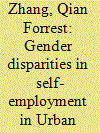

|
|
|
|
|
| Publication |
2013.
|
| Summary/Abstract |
This article presents the first quantitative analysis of gender disparities in self-employment in urban China. It documents the extent of gender income inequality in self-employment. By disaggregating self-employment into three occupational classes, it reveals the gender segregation within self-employment - women were concentrated in the financially least rewarding segment - and identifies it as a main source of gender income inequality. I examine a range of determinants of participation in self-employment, including family structure, family background and career history, and how their gender-specific effects contribute to gender segregation. Although using data from a 1996 national survey, this study captures two key processes that shaped the structure of self-employment in contemporary urban China: the restructuring of the state sector and the growth of financial returns and social status in the private sector, both of which contributed to the formation of gender segregation in self-employment.
|
|
|
|
|
|
|
|
|
|
|
|
|
|
|
|
| 2 |
ID:
164836
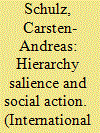

|
|
|
|
|
| Summary/Abstract |
Hierarchy is a persistent feature of international politics. Existing accounts recognize that there are many ways in which actors can stand in relation to one another. Yet they struggle to make sense of this complexity. This study considers Max Weber’s contribution to understanding international hierarchy. It discusses three ideal types of stratification based on the distribution of capabilities (class), estimations of honor and prestige (status), and command relationships (authority). Following the neo-Weberian approach, these dimensions matter because they make social action intelligible. Furthermore, Weber clarifies how class and status are connected and how these two dimensions relate to authority through the process of ‘social closure’. The study concludes that scholars who focus exclusively on authority structures miss the fact that authority typically derives from other forms of stratification: although based on different logics of social stratification, class and status hierarchies often coalesce into (legitimate) authority.
|
|
|
|
|
|
|
|
|
|
|
|
|
|
|
|
| 3 |
ID:
140874
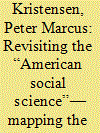

|
|
|
|
|
| Summary/Abstract |
This paper studies the geography of the International Relations (IR) discipline, particularly the notion that IR is an “American social science.” First, it analyzes bibliometric data and finds that US-based scholars continue to dominate IR journals, but also that IR is one of the least US-dominated social sciences and that it has become markedly less so since the 1960s. Second, the paper argues that conventional measures based on nation-state affiliation capture only part of the spatial structures of inequality. It employs novel visualization tools to present an alternative map of elite stratification in IR. Instead of looking at national cores and peripheries, it maps the social network structures of authorship and coauthorship in key IR journals. By mapping city and institutional output, it finds stratification structures within the American discipline. Elite institutions in Northeast America, rather than “America,” dominate the field's leading journals. A similar stratification is found in Western Europe. Moreover, network linkages in terms of both coauthorships and doctoral backgrounds tie these Northeast American and West European elites together. The paper concludes that while US dominance in IR journals is in decline, this has not yet made the discipline as international as its name warrants.
|
|
|
|
|
|
|
|
|
|
|
|
|
|
|
|
| 4 |
ID:
116486
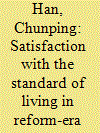

|
|
|
|
|
| Publication |
2012.
|
| Summary/Abstract |
Popular satisfaction with current standards of living in reform-era China is explored in this article, using survey data from the 2004 China Inequality and Distributive Justice Project. Three major patterns are found: first, people of rural origin, with low levels of education and living in the west region, who are disadvantaged in the inequality hierarchy, report greater satisfaction with current standards of living than do privileged urbanites, the highly educated and residents in the coastal east. Second, inequality-related negative life experiences and social cognitive processes including temporal and social comparisons, material aspirations, and life goal orientations mediate the effects of socioeconomic characteristics. Third, the social sources of satisfaction with current standards of living vary across urban, rural and migrant residents. It is suggested that these patterns have largely stemmed from the unique political economic institutional arrangement and stratification system in China.
|
|
|
|
|
|
|
|
|
|
|
|
|
|
|
|
| 5 |
ID:
184045
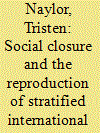

|
|
|
|
|
| Summary/Abstract |
This article investigates how the means by which actors compete for position in the management of international society stratifies international order. Advancing scholarship on hierarchies, it applies a theory of social closure to examine two status groups, The Family of Civilised Nations and the G20, arguing that stratification is reproduced by a dynamic interplay of top-down collectivist exclusion on the part of superiorly positioned actors and bottom-up mimicry performed by those inferiorly positioned. As such, the same means of closure which used the Standard of Civilisation to exclude outsiders from the Family of Civilised Nations in the past stratifies non-state actors today, particularly international non-governmental organisations (INGOs) seeking to play a role in-the G20. This article offers amendments to closure theory in International Relations (IR), demonstrating its utility for analysing contemporary international politics, engaging in trans-historical analysis, and in incorporating non-state actors into enquiry.
|
|
|
|
|
|
|
|
|
|
|
|
|
|
|
|
| 6 |
ID:
178167
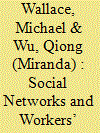

|
|
|
|
|
| Summary/Abstract |
Guanxi is the central form of social capital in Chinese society that provides access to resources, assets, and benefits that facilitate social status and social mobility. Substantial empirical research has documented the importance of guanxi networks in accessing resources for getting good jobs, moving up to better jobs, and achieving higher wages. Chinese Lunar New Year is a special occasion of cultural and social significance to cultivate and maintain guanxi networks. We thus conceptualize guanxi networks as the visiting networks during the Chinese New Year celebration. Using the 2008 Chinese General Social Survey, we construct five measures of the Chinese New Year greeting networks and assess their impact on workers’ earnings as well as gender differences in their effects on earnings. We also consider two major structural constraints—the hukou and social class—that affect the extent of one’s social networks and earnings. Our findings not only confirm the overall positive effects of the Chinese New Year greeting networks on earnings but also offer nuances that enhance the understanding of how guanxi networks as a manifestation of social capital embedded in Chinese traditional culture work in the contemporary era and intensify gender gaps.
|
|
|
|
|
|
|
|
|
|
|
|
|
|
|
|
| 7 |
ID:
168870
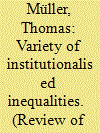

|
|
|
|
|
| Summary/Abstract |
This article argues that the research on institutionalised inequalities pays too little attention to competing understandings of stratification and the variety of interlinkages between the patterns of stratification and the institutions of international society. Building on the English School and theories of stratification, it develops an analytical framework that conceptualises these ‘stratificatory interlinkages’ as a twofold decision: firstly for a coupling – instead of a decoupling – of institutional characteristics to patterns of stratification and secondly for a specific classification scheme and type of interlinkage. The article draws on empirical examples from the League of Nations and other interwar international institutions to demonstrate that different understandings of stratification and classification schemes were used for different institutional purposes, for example, voting rights and the apportionment of budget expenses. In addition, it proposes four analytical dimensions that allow mapping the variety of classification schemes and types of interlinkages that were chosen for institutionalised inequalities. The dimensions relate to the composition of the reference group, the decision-making about the classification scheme, the institutional purposes, and the institutional form of the interlinkage. The variety of stratificatory interlinkages entails a more variable and diverse relation between stratification and institutions than usually assumed.
|
|
|
|
|
|
|
|
|
|
|
|
|
|
|
|
|
|
|
|
|